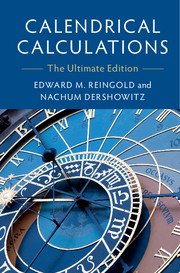Book contents
Preface
Published online by Cambridge University Press: 22 March 2018
Summary
No one has the right to speak in public before he has rehearsed what he wants to say two, three, and four times, and learned it; then he may speak … But if a man … puts it down in writing, he should revise it a thousand times, if possible.
Maimonides: The Epistle on Martyrdom (circa 1165)This book has developed over a more than 30-year period during which the calendrical algorithms and our presentation of them have continually evolved. Our initial motivation was an effort by one of us (E.M.R.) to create Emacs-Lisp code that would provide calendar and diary features for GNU Emacs [15]; this version of the code included the Gregorian, Islamic, and Hebrew calendars (the Hebrew implemented by N.D.). A deluge of inquiries from around the globe soon made it clear to us that there was keen interest in an explanation that would go beyond the code itself, leading to our article [3] and encouraging us to rewrite the code completely, this time in Common Lisp [16]. The subsequent addition—by popular demand—of the Mayan and French Revolutionary calendars to GNU Emacs prompted a second article [13]. We received many hundreds of reprint requests for these articles. This response far exceeded our expectations and provided the impetus to write a book in which we could more fully address the multifaceted subject of calendars and their implementation.
The subject of calendars has always fascinated us with its cultural, historical, and mathematical wealth, and we have occasionally employed calendars as accessible examples in introductory programming courses. Once the book's plan took shape, our curiosity turned into obsession. We began by extending our programs to include other calendars such as the Chinese, Coptic, modern Hindu, and arithmetic Persian. Then, of course, the code for these newly added calendars needed to be rewritten, in some cases several times, to bring it up to the standards of the earlier material. We have long since lost track of the number of revisions, and, needless to say, we could undoubtedly devote another decade to polishing what we have, tracking down minutiæ, and implementing and refining additional interesting calendars. As much as we might be tempted to, circumstances do not allow us to follow Maimonides’ dictum quoted above.
- Type
- Chapter
- Information
- Calendrical CalculationsThe Ultimate Edition, pp. xxxi - xlPublisher: Cambridge University PressPrint publication year: 2018

